EIGRP Questions 5
Here you will find answers to EIGRP Questions – Part 5
Question 1
Which three descriptions are correct based on the exhibited output? (Choose three)
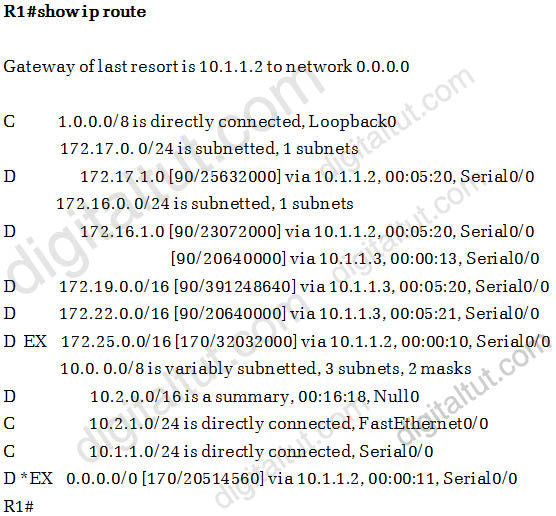
A. R1 is configured with the variance command.
B. The route to 10.2.0.0/16 was redistributed into EIGRP.
C. A default route has been redistributed into the EIGRP autonomous system.
D. R1 is configured with the ip summary-address command.
Answer: A C D
Explanation
From the routing table above, we see that network 172.16.1. can be reached via 2 unequal paths (with FD of 23072000 & 20640000) so surely R1 has been configured with the “variance” command -> A is correct.
By configuring a default route and redistribute it into EIGRP you will get the line “D *EX 0.0.0.0/0 …” line in the routing table of that router -> C is correct.
From the line “10.2.0.0/16 is a summary, 00:16:18, Null0” we know that this network has been summarized with the “ip summaray-address” command (notice that 10.2.0.0 is not the major network of net-> D is correct.
Question 2
Refer to the exhibit. Which two statements are true? (Choose two)
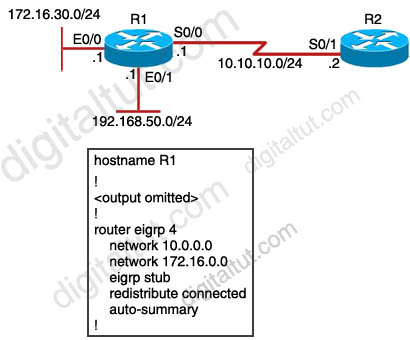
A. The eigrp stub command prevents queries from being sent from R2 to R1.
B. The eigrp stub command will automatically enable summarization of routes on R2.
C. The eigrp stub command prevents all routes except a default route from being advertised to R1.
D. Router R1 will advertise connected and summary routes only.
E. Router R1 will advertise connected and static routes. The sending of summary routes will not be permitted.
F. Router R1 is configured as a receive-only neighbor and will not send any connected, static or summary routes.
Answer: A D
Explanation
The command “eigrp stub” turns R1 into a stub router so R2 will never send any query to R1 because R2 knows that a stub router will only route packets for networks it has explicitly advertised -> A is correct.
The command “eigrp stub” is same as “eigrp stub connected summary” command because connected and summarized routes are advertised by default -> D is correct.
Note: Because the network 192.168.50.0 is not advertised by “network” statement, it is necessary to redistribute connected route with the “redistribute connected” command.
Question 3
Refer to the exhibits. Router B should advertise the network connected to the E0/0/0 interface to router A and block all other network advertisements. The IP routing table on router A indicates that it is not receiving this prefix from router B.
What is the probable cause of the problem?
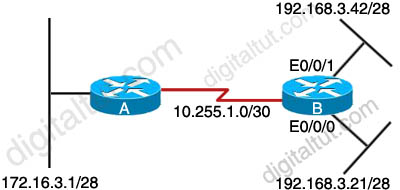
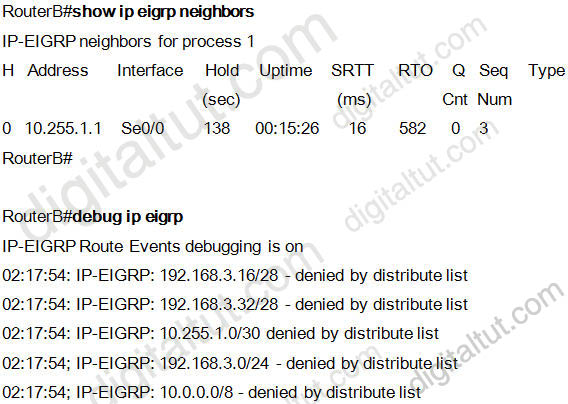
A. An access list on router B is causing the 192.168.3.16/28 network to be denied.
B. An access list on router B is causing the 192.168.3.32/28 network to be denied.
C. The distribute list on router B is referencing a numbered access list that does not exist on router B.
D. The distribute list on router B is referencing the wrong interface.
Answer: A
Explanation
This is an unclear question. The question says “Router B should advertise the network connected to the E0/0/0 interface to router A and block all other network advertisements. The IP routing table on router A indicates that it is not receiving this prefix from router B.” That means the network 192.168.3.16/28 (including the IP 192.168.3.21/28) is not received on router A -> A is the most suitable answer.
Note: Distribute list are used to filter routing updates and they are based on access lists.
Question 4
Study the exhibit carefully. What must be done on router A in order to make EIGRP work effectively in a Frame Relay multipoint environment?
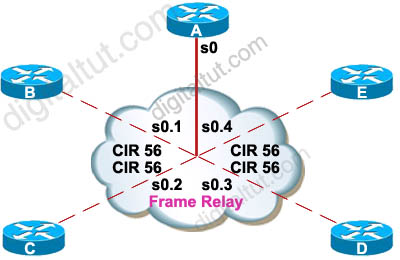
A. Issue the command bandwidth 56 on the physical interface.
B. Issue the command bandwidth 56 on each subinterface.
C. Issue the command bandwidth 224 on each subinterface.
D. Issue the command bandwidth 224 on the physical interface.
Answer: D
Explanation
In Frame Relay, all neighbors share the same bandwidth, regardless of the actual CIR of each individual PVC. In this case the CIR of each PVC is the same so we can find the bandwidth of the main interface (multipoint connection interface) by 56 x 4 = 224.
Notice that if the bandwidth on each PVC is not equal then we get the lowest bandwidth to multiply.
Question 5
Refer to the exhibit. ROUTE Enterprises has many stub networks in their enterprise network, such as router B and its associated network. EIGRP is to be implemented on router A so that neither the prefix for the S/0/0/0 interface nor the prefixes from router B appear in the routing tables for the router in the enterprise network.
Which action will accomplish this goal?

A. Declare router B a stub router using the eigrp stub command.
B. Use the passive-interface command for interface Serial0/0/0.
C. Use a mask with the network command to exclude interface Serial0/0/0.
D. Implement a distribute list to exclude the link prefix from the routing updates.
Answer: C
Explanation
If we declare router B a stub router then the routers in Enterprise Network still learn about the network for S0/0/0 interface and the network behind router B -> A is not correct.
If we use the passive-interface command on s0/0/0 interface then router A & B can not become neighbor because they don’t exchange hello messages -> A can not send traffic to the network behind B -> B is not correct.
Theoretically, we can use a distribute list to exclude both the link prefix and the prefix from router B but it is not efficient because:
+ We have many stub networks so we will need a “long” distribute list.
+ We declare networks in stub routers (like router B) while filter them out at router A -> it is a waste.
I am not totally sure about answer C because if we “use a mask with the network command to exclude interface Serial0/0/0” then router A and B can not become neighbors and the situation is same as answer B. But from many discussions about this question, maybe C is the best answer.
Question 6
Refer to the exhibit. EIGRP is configured with the default configuration on all routers. Autosummarization is enabled on routers R2 and R3, but it is disabled on router R1. Which two EIGRP routes will be seen in the routing table of router R3? (Choose two)
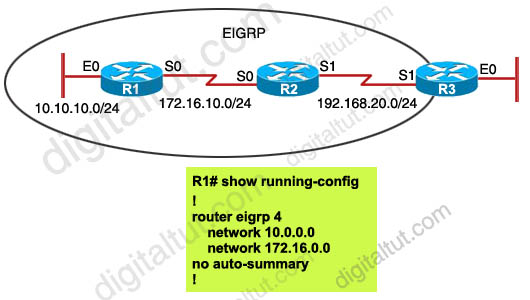
A. 10.0.0.0/8
B. 10.10.0.0/16
C. 10.10.10.0/24
D. 172.16.0.0/16
E. 172.16.0.0/24
F. 172.16.10.0/24
Answer: C D
Explanation
EIGRP performs an auto-summarization each time it crosses a border between two different major networks. In this case all different networks are in different major networks so EIGRP will perform auto-summarization when it exits an interface. But R1 has been configured with “no auto-summary” command so EIGRP will not summarize on S0 interface of R1. So the routing table of R2 will have the network 10.10.10.0/24 (not be summarized).
When exiting S1 interface of R2, EIGRP summarizes network 172.16.10.0/24 into the major 172.16.0.0/16 network but it does not summarize network 10.10.10.0/24 because it is not directly connected with this network. Therefore in the routing table of R3 there will have:
+ Network 10.10.10.0/24 ( not summarized)
+ Network 172.16.0.0/16 (summarized)
-> C and D are correct.
Note: I simulated this question on GNS3, you can see the final outputs of the “show ip route” commands on these routers (I connected these routers via FastEthernet, not Serial interfaces so the outputs are slightly different but the main points are not changed).
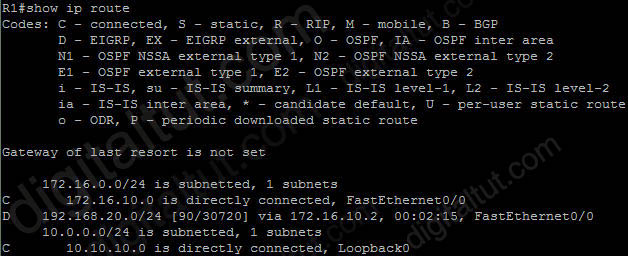
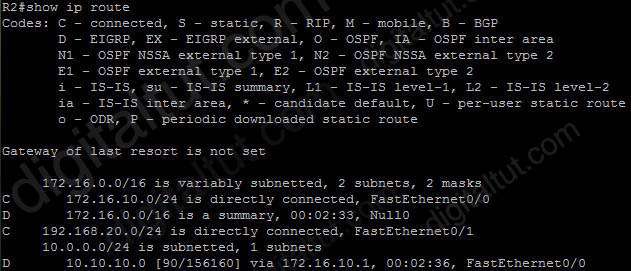
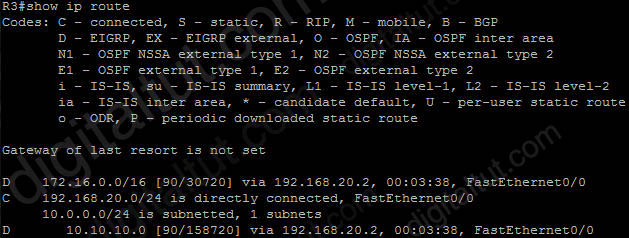
Question 7
Refer to the exhibit. In a redundant hub-and-spoke deployment using EIGRP, what feature can be used to ensure that routers C through F are not used as transit routers for data traveling from router B to network 10.1.1.0?
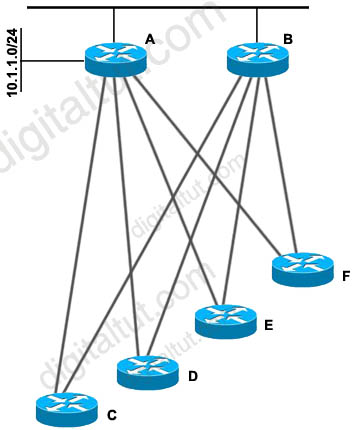
A. Use address summarization at routers C, D. E, and F.
B. Use the EIGRP Stub feature on routers C, D, E, and F.
C. Use passive-interface on the spoke links in routers A and B.
D. Change the administrative distance in routers A and B for routes learned from routers Cr D. E, and F.
Answer: B
Explanation
By configuring “stub” feature on routers C D E and F, routers A and B will not try to transit traffic through these routers. For example, if the network connecting from routers A and B is down, router B will not send to network 10.1.1.0/24 from router B -> routerC/D/E/F -> router A -> network 10.1.1.0/24.
Question 8
Refer to the exhibit. How would you confirm on R1 that load balancing is actually occurring on the default-network (0.0.0.0)?
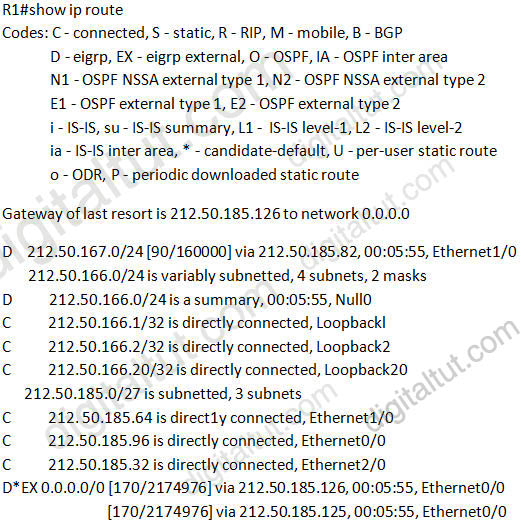
A. Use ping and the show ip route command to confirm the timers for each default network resets to 0.
B. Load balancing does not occur over default networks; the second route will only be used for failover.
C. Use an extended ping along with repeated show ip route commands to confirm the gateway of last resort address toggles back and forth.
D. Use the traceroute command to an address that is not explicitly in the routing table.
Answer: D
Explanation
The most simple method to test load balancing is to use the “traceroute” command. If load balancing is working correctly, we will see different paths to reach the destination each time we use that command.
Unknown address will be routed via the default-network 0.0.0.0 so we must use an address that is not explicitly in the routing table.
Question 9
Refer to the exhibit. ROUTE.com is planning to implement load balancing for traffic between host on the 172.16.10.0/24 and 172.16.20./24 networks. You have been asked to review the implementation plan for this project. Which statement about the plan is true?
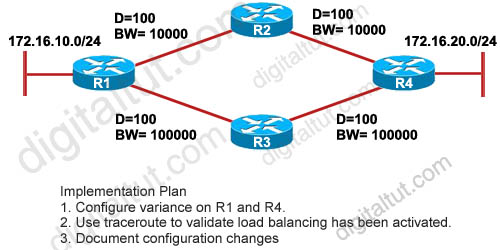
A. It is complete as written.
B. It should include a task to configure EIGRP multipath equal to 2 on R1 and R4.
C. It should include a task to implement OSPF because it handles unequal cost load balancing most efficiently using variance.
D. It should include a task that establishes a baseline before and after the configuration has been changed.
Answer: D
Explanation
A complete implementation plan should be:
1. Configure variance on R1 and R4
2. Use traceroute to validate load balancing has been activated
3. Document configuration changes
4. Establish a new traffic throughput baseline
5. Compare the new and old baselines and verify that load balancing is implemented as desired.
Question 10
Refer to the exhibit. ROUTE.com is planning to implement load balancing for traffic between host on the 172.16.10.0/24 and 172.16.20./24 networks. You have been asked to review the implementation plan for this project. Which statement about the plan is true?
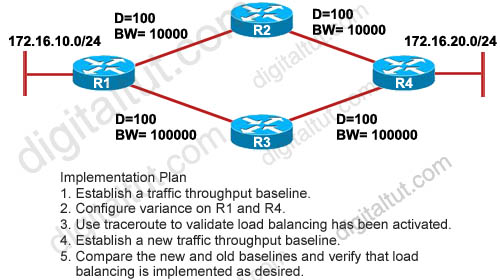
A. It is complete as written.
B. It should include a task to configure multipath to equal a value of 2 on R1 and R4.
C. It should use a ping instead of a traceroute to validate that load balancing has been activated.
D. It should contain a task that documents the changes made to the configurations.
Answer: D
Explanation
Same as questions 9
Question 11
Refer to the exhibit. EIGRP had converged in AS 1 when the link between router R1 and R2 went down. The console on router R2 generated the following messages:
| *Mar 20 12:12:06: %DUAL-5-NBRCHANGE: IP-EIGRP 1: Neighbor 10.1.4.3 (Serial0) is down: stuck in active *Mar 20 12:15:23: %DUAL-3-SIA: Route 10.1.1.0/24 stuck-in-active state in IP-EIGRP 1. Cleaning up |
The network administrator issued the show ip eigrp topology active command on R2 to check the status of the EIGRP network. Which statement best describes the reason for the error messages?
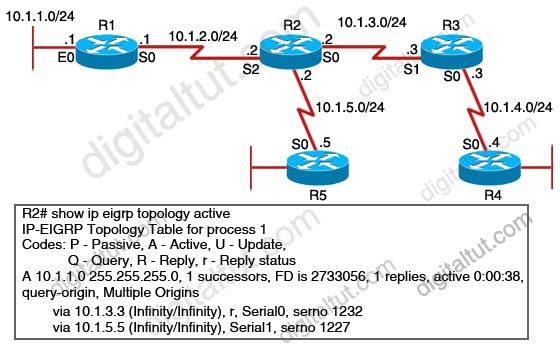
A. Incorrect bandwidth configuration on router R3 prevents R2 from establishing neighbor adjacency.
B. Incorrect bandwidth configuration on router R5 prevents R2 from establishing neighbor adjacency.
C. Router R3 did not reply to the query about network 10.1.1.0/24 sent by router R2.
D. Router R5 did not reply to the query about network 10.1.1.0/24 sent by router R2.
Answer: C
Explanation
When the link between R1 and R2 is down, R2 loses its successor for the network 10.1.1.0/24. R2 checks its topology table for a feasible successor but it can’t find one. So R2 goes active on the that route to find a new successor by sending queries out to its neighbors (R3 and R5) requesting a path to the lost route. Both R3 and R5 also go “active” for the that route. But R5 doesn’t have any neighbor to ask besides R2 so it will send an “unreachable message” to indicate it has no alternative path for that route and has no other neighbor to query. R3 also checks its EIRGP topology table for a feasible successor but it has none, too. Unlike R5, R3 has a neighbor (R4) so it continues to query this router.
Now suppose there is a problem on the link between R3 and R4 so R4 never receives the query from R3 and of course, R3 also never receives a reply back from R4. Therefore, R3 can’t reply back to R2. After about 3 minutes, the “Stuck in active” (SIA) timer on R2 expires and R2 marks the route 10.1.1.0/24 as “stuck in active” route.
The output line “via 10.1.3.3 (Infinity/Infinity), r, Seiral0, serno 1232” indicates R2 has sent a query to 10.1.3.3 and is waiting for a reply (the lowercase r) -> C is correct.
(Reference: http://www.cisco.com/en/US/tech/tk365/technologies_tech_note09186a008010f016.shtml)
Question 12
Refer to the exhibit. EIGRP has been configured on routers R1 and R2. However, R1 does not show R2 as a neighbor and does not accept routing updates from R2. What could be the cause of the problem?
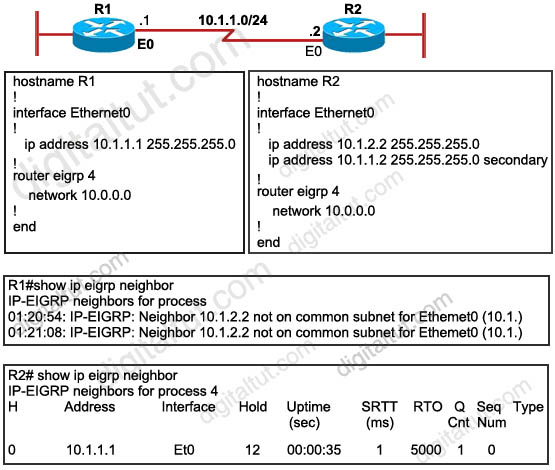
A. The no auto-summary command has not been issued under the EIGRP process on both routers.
B. Interface E0 on router R1 has not been configured with a secondary IP address of 10.1.2.1/24.
C. EIGRP cannot exchange routing updates with a neighbor’s router interface that is configured with two IP addresses.
D. EIGRP cannot form neighbor relationship and exchange routing updates with a secondary address.
Answer: D
Explanation
EIGRP updates always use the primary IP address of the outgoing interface as the source address. In this case R2 will use the 10.1.2.2/24 address, which is not in the same subnet of R1, to send EIGRP update to R1. Therefore R1 does not accept this update and generates the “not on common subnet” error message.
Answer D is a bit unclear. It should state that “EIGRP cannot form neighbor relationship and exchange routing updates if the two primary addresses on two routers are not in the same subnet”.
Notice that although R1 does not accept R2 as its EIGRP neighbors but R2 accepts R1 as its EIGRP neighbor accepts R1 hello packets..
For more information about this problem, please read http://www.cisco.com/en/US/tech/tk365/technologies_configuration_example09186a0080093f09.shtml.
Question 13
Refer to the exhibit. A Boston company bought the assets of a New York company and is trying to route traffic between the two data networks using EIGRP over EoMPLS. As a network consultant, you were asked to verify the interoperability of the two networks.
From the show ip route command output, what can you tell the customer about the traffic flow between the subnet in New York (172.16.8.0/24) and the subnets in Boston (172.16.16.0/24 and 10.10.16.0/24)?
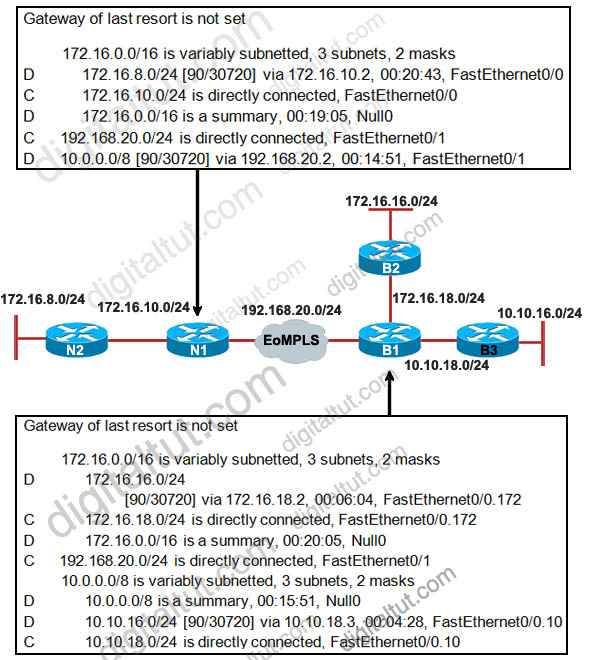
A. Traffic is flowing between the 172.16.8.0 subnet and subnets 172.16.16.0 and 10.10.16.0 and no configuration changes are needed.
B. Auto-summary must be disabled on N1 and B1 before traffic can flow between the 172.16.8.0 subnet and subnets 172.16.16.0 and 10.10.16.0.
C. Traffic will flow between the 172.16.8.0 subnet and 172.16.16.0 without any further configuration changes. However, auto-summary must be disabled on N1 and B1 before traffic can flow between the 172.16.8.0 subnet and the 10.10.16.0 subnet.
D. Auto-summary must be disabled on N1 and B1 before traffic can flow between the 172.16.8.0 subnet and the 172.16.16.0 subnet. However, traffic will flow between the 172.16.8.0 subnet and 10.10.16.0 without any further configuration changes.
Answer: B
Question 14
Refer to the exhibit. A Boston company bought the assets of a New York company and is trying to route traffic between the two data networks using EIGRP. The show command output shows that traffic will not flow between the networks. As a network consultant, you were asked to modify the configuration and certify the interoperability of the two networks. For traffic to flow from subnet 172.16.8.0/24 to the 172.16.16.0/24 subnet, which configuration change do you recommend?
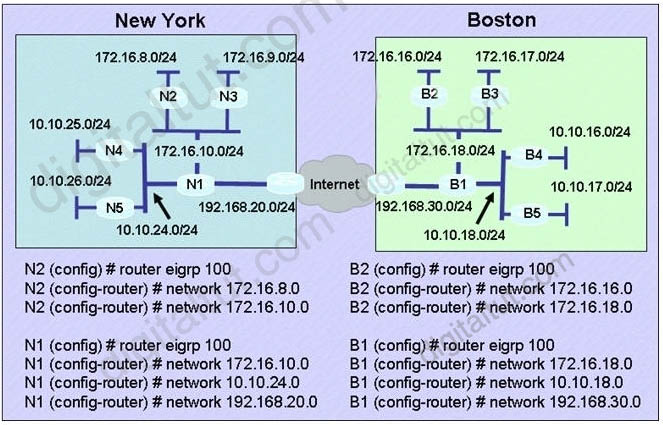
A. Turn off autosummarization on routers N1 and B1.
B. Add IP summary addresses to the Internet-pointing interfaces of routers N1 and B1.
C. Turn off autosummarization on routers N2 and B2.
D. Add wildcard masks to the network commands on routers N2 and B2.
Answer: A



“After a great performance but a bad result I had a phone call from King Diego.
superstar scratch femme http://www.terres-et-formes.com/asp/Catalogue.asp?PasCher=superstar-scratch-femme
I cherished up to you’ll obtain performed proper here. The sketch is tasteful, your authored material stylish. nevertheless, you command get bought an edginess over that you want be turning in the following. sick undoubtedly come further formerly again as exactly the similar just about a lot frequently inside of case you shield this increase. QBEAKWJUFNECUWBVRE http://QBEAKWJUFNECUWBVRE.com
Lovely blog! I am loving it!! Will be back later to read some more. I am bookmarking your feeds also. CXLIXFERUCNXKSF http://CXLIXFERUCNXKSF.com